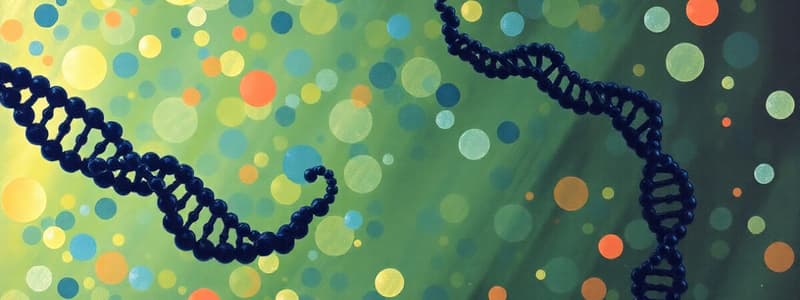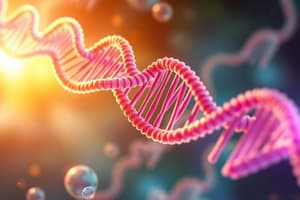Podcast
Questions and Answers
What effect does RNA editing have on the apo-B gene?
What effect does RNA editing have on the apo-B gene?
- It alters the sequences of pre-mRNAs. (correct)
- It suppresses the production of serum lipoproteins.
- It creates a single protein isoform.
- It reduces the expression of the apo-B gene.
What is the primary function of ApoB-100?
What is the primary function of ApoB-100?
- Binding to LDL receptors for cholesterol delivery. (correct)
- Formation of lipoprotein complexes.
- Catalyzing lipid synthesis.
- Transport of glucose to cells.
What roles do nuclear pore complexes (NPCs) play in cellular transport?
What roles do nuclear pore complexes (NPCs) play in cellular transport?
- They allow free diffusion of proteins larger than 40 kDa.
- They modify mRNAs.
- They facilitate the export of fully processed mRNAs. (correct)
- They serve as sites for protein synthesis.
Which type of proteins are responsible for the structure of nuclear pore complexes?
Which type of proteins are responsible for the structure of nuclear pore complexes?
What type of nucleoporins are involved in forming the annular structures of the NPC?
What type of nucleoporins are involved in forming the annular structures of the NPC?
How do small proteins up to 40 kDa interact with nuclear pore complexes?
How do small proteins up to 40 kDa interact with nuclear pore complexes?
What modifications occur to the apo-B mRNA gene during RNA editing?
What modifications occur to the apo-B mRNA gene during RNA editing?
What structure forms the 'nuclear basket' associated with nuclear pore complexes?
What structure forms the 'nuclear basket' associated with nuclear pore complexes?
What process occurs first during the maturation of mRNA in eukaryotic cells?
What process occurs first during the maturation of mRNA in eukaryotic cells?
Which sequence is a conserved polyadenylation signal in mRNAs?
Which sequence is a conserved polyadenylation signal in mRNAs?
What role does the cleavage stimulatory factor (CStF) play in mRNA processing?
What role does the cleavage stimulatory factor (CStF) play in mRNA processing?
During polyadenylation, what protein accelerates the rate of adenine residue addition?
During polyadenylation, what protein accelerates the rate of adenine residue addition?
Which of the following statements about RNA splicing is true?
Which of the following statements about RNA splicing is true?
What is the primary function of poly(A) polymerase (PAP)?
What is the primary function of poly(A) polymerase (PAP)?
Which factor is exchanged after mRNA is transported into the cytoplasm?
Which factor is exchanged after mRNA is transported into the cytoplasm?
What is the role of the spliceosome in mRNA processing?
What is the role of the spliceosome in mRNA processing?
What happens to phosphorylated Npl3 after successful polyadenylation?
What happens to phosphorylated Npl3 after successful polyadenylation?
What is the role of Sky1 in relation to Npl3?
What is the role of Sky1 in relation to Npl3?
What is the function of a nuclear-localization signal (NLS)?
What is the function of a nuclear-localization signal (NLS)?
Which proteins interact with cargo proteins during nuclear transport?
Which proteins interact with cargo proteins during nuclear transport?
How do importins and exportins navigate through nuclear pores?
How do importins and exportins navigate through nuclear pores?
What happens when a cargo complex reaches its destination?
What happens when a cargo complex reaches its destination?
Which statement about nuclear-export signals (NES) is true?
Which statement about nuclear-export signals (NES) is true?
What characterizes proteins that shuttle between the nucleus and cytoplasm?
What characterizes proteins that shuttle between the nucleus and cytoplasm?
What is the role of RNA-binding proteins in mRNA regulation?
What is the role of RNA-binding proteins in mRNA regulation?
What happens to ferritin mRNA translation at low iron levels?
What happens to ferritin mRNA translation at low iron levels?
How does the transferrin receptor (TfR) mRNA respond to low iron concentrations?
How does the transferrin receptor (TfR) mRNA respond to low iron concentrations?
What triggers the degradation of transferrin receptor mRNA at high iron levels?
What triggers the degradation of transferrin receptor mRNA at high iron levels?
What is the function of ferritin in the cell?
What is the function of ferritin in the cell?
What is a characteristic feature of mRNA surveillance mechanisms?
What is a characteristic feature of mRNA surveillance mechanisms?
Which protein is responsible for binding to the iron response elements in mRNAs?
Which protein is responsible for binding to the iron response elements in mRNAs?
What is the relationship between iron levels and the activity of IRE-BP?
What is the relationship between iron levels and the activity of IRE-BP?
What bond is formed during the first transesterification catalyzed by the catalytic core of U6 and U2?
What bond is formed during the first transesterification catalyzed by the catalytic core of U6 and U2?
Which complex is responsible for rapidly degrading excised introns?
Which complex is responsible for rapidly degrading excised introns?
What role do nuclear exonucleases play in RNA degradation?
What role do nuclear exonucleases play in RNA degradation?
What distinguishes the AU-AC introns from the usual GU-AG intron rule?
What distinguishes the AU-AC introns from the usual GU-AG intron rule?
What happens to antisense RNA that is transcribed in the wrong direction?
What happens to antisense RNA that is transcribed in the wrong direction?
How do RNA helicases contribute to RNA degradation?
How do RNA helicases contribute to RNA degradation?
What is the consequence of the presence of polyadenylation signals (PAS) in the coding regions of pre-mRNA?
What is the consequence of the presence of polyadenylation signals (PAS) in the coding regions of pre-mRNA?
What is the function of the snRNPs in the splicing cycle of AU-AC introns?
What is the function of the snRNPs in the splicing cycle of AU-AC introns?
What is required for translation initiation?
What is required for translation initiation?
What effect does phosphorylation of CPEB have during ovulation?
What effect does phosphorylation of CPEB have during ovulation?
What is formed when PABPC1 binds to the elongated poly(A) tail and eIF4G?
What is formed when PABPC1 binds to the elongated poly(A) tail and eIF4G?
What occurs when the poly(A) tail is shortened to 20 residues?
What occurs when the poly(A) tail is shortened to 20 residues?
In the deadenylation-dependent pathway, what happens to the deadenylated mRNA?
In the deadenylation-dependent pathway, what happens to the deadenylated mRNA?
Which mechanism involves decapping mRNA before it is deadenylated?
Which mechanism involves decapping mRNA before it is deadenylated?
How are short-lived mRNAs typically characterized?
How are short-lived mRNAs typically characterized?
What role does the interaction between the 5’ cap and translation initiation factors play?
What role does the interaction between the 5’ cap and translation initiation factors play?
Flashcards
3' Cleavage and Polyadenylation
3' Cleavage and Polyadenylation
A crucial process in eukaryotic gene expression, where pre-mRNAs are cleaved and a poly(A) tail is added to the 3' end, essential for mRNA stability, translation, and export.
Poly(A) tail
Poly(A) tail
A string of adenine nucleotides added to the 3' end of most eukaryotic mRNAs, after cleavage.
Polyadenylation Signal (AAUAAA)
Polyadenylation Signal (AAUAAA)
A short nucleotide sequence (AAUAAA) found in pre-mRNA, acting as a signal for the addition of the poly(A) tail, located upstream of the poly(A) site.
Cleavage Stimulatory Factor (CStF)
Cleavage Stimulatory Factor (CStF)
Signup and view all the flashcards
Cleavage and Polyadenylation Specificity Factor (CPSF)
Cleavage and Polyadenylation Specificity Factor (CPSF)
Signup and view all the flashcards
Poly(A) Polymerase (PAP)
Poly(A) Polymerase (PAP)
Signup and view all the flashcards
RNA Splicing
RNA Splicing
Signup and view all the flashcards
Spliceosome
Spliceosome
Signup and view all the flashcards
Transesterification
Transesterification
Signup and view all the flashcards
Exons
Exons
Signup and view all the flashcards
Introns
Introns
Signup and view all the flashcards
Splicing
Splicing
Signup and view all the flashcards
snRNPs
snRNPs
Signup and view all the flashcards
Exosome
Exosome
Signup and view all the flashcards
5' and 3' exonucleases
5' and 3' exonucleases
Signup and view all the flashcards
RNA helicases
RNA helicases
Signup and view all the flashcards
Polyadenylation Signal (PAS)
Polyadenylation Signal (PAS)
Signup and view all the flashcards
AU-AC introns
AU-AC introns
Signup and view all the flashcards
RNA Editing
RNA Editing
Signup and view all the flashcards
ApoB isoforms
ApoB isoforms
Signup and view all the flashcards
ApoB-100 function
ApoB-100 function
Signup and view all the flashcards
RNA editing enzyme
RNA editing enzyme
Signup and view all the flashcards
Nuclear mRNPs
Nuclear mRNPs
Signup and view all the flashcards
Nuclear Pore Complexes (NPCs)
Nuclear Pore Complexes (NPCs)
Signup and view all the flashcards
NPC Size
NPC Size
Signup and view all the flashcards
Nuclear Pore Components
Nuclear Pore Components
Signup and view all the flashcards
Free Diffusion through NPCs
Free Diffusion through NPCs
Signup and view all the flashcards
Translation Initiation
Translation Initiation
Signup and view all the flashcards
Iron-sensitive RNA-binding protein
Iron-sensitive RNA-binding protein
Signup and view all the flashcards
eIF4E binding to eIF4G
eIF4E binding to eIF4G
Signup and view all the flashcards
Ferritin mRNA translation
Ferritin mRNA translation
Signup and view all the flashcards
Transferrin receptor (TfR) mRNA degradation
Transferrin receptor (TfR) mRNA degradation
Signup and view all the flashcards
Progesterone Stimulation
Progesterone Stimulation
Signup and view all the flashcards
Iron response elements (IREs)
Iron response elements (IREs)
Signup and view all the flashcards
CPEB phosphorylation
CPEB phosphorylation
Signup and view all the flashcards
mRNA surveillance
mRNA surveillance
Signup and view all the flashcards
CPSF binding
CPSF binding
Signup and view all the flashcards
RNA degradation
RNA degradation
Signup and view all the flashcards
Poly(A) tail growth
Poly(A) tail growth
Signup and view all the flashcards
Iron-response element-binding proteins (IRE-BP)
Iron-response element-binding proteins (IRE-BP)
Signup and view all the flashcards
PABPC1 binding
PABPC1 binding
Signup and view all the flashcards
mRNA 3' or 5' UTRs
mRNA 3' or 5' UTRs
Signup and view all the flashcards
Polysome
Polysome
Signup and view all the flashcards
mRNA degradation (deadenylation)
mRNA degradation (deadenylation)
Signup and view all the flashcards
Decapping
Decapping
Signup and view all the flashcards
Deadenylation-independent pathway
Deadenylation-independent pathway
Signup and view all the flashcards
mRNA stability
mRNA stability
Signup and view all the flashcards
AU-rich sequences
AU-rich sequences
Signup and view all the flashcards
Phosphorylated Npl3
Phosphorylated Npl3
Signup and view all the flashcards
Glc7 nuclear phosphatase
Glc7 nuclear phosphatase
Signup and view all the flashcards
NXF1/NXT1
NXF1/NXT1
Signup and view all the flashcards
mRNP complex
mRNP complex
Signup and view all the flashcards
Nuclear Pore Complex (NPC)
Nuclear Pore Complex (NPC)
Signup and view all the flashcards
Sky1 protein kinase
Sky1 protein kinase
Signup and view all the flashcards
Nuclear Export/Import
Nuclear Export/Import
Signup and view all the flashcards
Nuclear Localization Signal (NLS)
Nuclear Localization Signal (NLS)
Signup and view all the flashcards
Nuclear Export Signal (NES)
Nuclear Export Signal (NES)
Signup and view all the flashcards
Karyopherins
Karyopherins
Signup and view all the flashcards
FG-nucleoporins
FG-nucleoporins
Signup and view all the flashcards
Ran G protein
Ran G protein
Signup and view all the flashcards
Study Notes
Post-Transcriptional Gene Control
- Eukaryotic pre-mRNA is processed to form mRNA through 5'-capping, 3' cleavage and polyadenylation, and RNA splicing.
- Alternative splicing of mRNA is regulated, involving splicing factors.
- Mechanisms for molecule transport through the nuclear pore complex are described.
- Cytoplasmic proteins and pathways affect post-transcriptional control of mRNA.
- Key terms include: 5' cap, alternative splicing, cleavage/polyadenylation complex, cross-exon recognition complex, FG-nucleoporins, nuclear pore complex, miRNA, mRNA surveillance, mRNP exporter, poly(A) tail, hnRNP, pre-mRNA, RNA editing, siRNA, RNA splicing, snRNA, spliceosome, SR proteins.
Introduction
- ~60% of human genes have alternatively spliced mRNA.
- The text includes a quote relating to the importance of sharpening one's skills/study habits for success, and encourages further discussion if needed.
9.1 Processing of Eukaryotic Pre-mRNA
- Eukaryotic pre-mRNA processing occurs in the nucleus involving 5'-capping, 3' cleavage and polyadenylation, and RNA splicing.
- 5'-cap involves addition of a 7-methylguanylate to the 5' end of pre-mRNA.
- A capping enzyme associated with RNA polymerase II phosphorylated CTD ensures only mRNA is capped.
- Unusual 5'-5' triphosphate bond is formed.
- Enzymes transfer a methyl group to ribose and guanine portions.
- Pre-mRNA associated with hnRNP proteins (heterogeneous ribonucleoprotein particles), preventing formation of short complementary intramolecular secondary structures.
- hnRNPs are abundant RNA-binding proteins containing hnRNA.
9.1. A 5' cap
- Added to nascent RNA after ~25 nucleotides.
- Composed of 7-methylGMP and methylated ribose.
- Cap marks RNA as mRNA.
- Removal of y-phosphate from 5' end of nascent mRNA.
- GMP moiety transferred to 5' diphosphate on mRNA.
9.1. B Pre-mRNA
- Associated with hnRNP proteins (heterogeneous ribonucleoprotein particles).
- hnRNPs are abundant RNA-binding proteins.
- hnRNPs contain hnRNA, which includes pre-mRNA and other nuclear RNAs.
- hnRNP proteins regulate splicing and transport of mRNA.
- hnRNPs facilitate the hybridization of splice factors and RNA, accelerating splicing.
9.1. C 3’ Cleavage and Polyadenylation
- Cleavage and polyadenylation occur at a conserved segment of pre-mRNA, followed by polyadenylation.
- Key segment typically consists of AAUAAA upstream from a polyadenylation signal site, where cleavage and polyadenylation occur.
9.1. C Continued
- Cleavage and Polyadenylation (CPSF) binds to AAUAAA; (CStF) binds to G/U site.
- Cleavage and polyadenylation specificity factors (CPSF), cleavage stimulatory factors (CStF), and other cleavage factors (CFI and CFII) assist in stabilization of the complex.
- Poly(A) polymerase (PAP) adds a string of adenosine nucleotides; PABPN1 accelerates the rate of this addition.
9.1. D RNA Splicing
- RNA splicing follows cleavage and polyadenylation, important for longer transcripts.
- Splicing occurs at conserved sequences (splice sites) in intron-exon junctions in pre-mRNA.
- ~30-40 nucleotides at each end of the intron are critical; 5’ GU and 3’ AG (or GU-AG) sequences important.
- Splicing involves two transesterification reactions catalysed by spliceosome, joining exons and removing the intron.
- Splicing utilizes small nuclear RNAs (snRNAs) and snRNPs (small nuclear ribonucleoprotein particles).
- Introns are excised, forming a lariat structure, which gets degraded. Five snRNAs—U1, U2, U4, U5, and U6 —play crucial roles in mRNA splicing.
9.1. D Continued
- Small nuclear RNAs (snRNAs), associated with 6-10 proteins in snRNPs.
- During splicing, snRNAs base-pair with pre-mRNA and other snRNAs, crucial for the splicing pathway.
- ~100-200 nucleotide snRNAs; U1 snRNA binds to the 5’ splice site.
9.1. E U2 snRNA
- U2 snRNA binds to branch point A.
- U2AF is a U2-associated factor associated with pyrimidine tract and 3’ AG splice site.
- U2 snRNP associates at branch point and displaces SF1.
- U4/U5/U6 complex forms the spliceosome with U1/U2/pre-mRNA.
- Rearrangements in base-pairing leads to U1 and U4 release.
- The catalytic core of U6 and U2, the first transesterification, forms the 2',5' phosphodiester bond.
- Second transesterification connects exons and releases lariat; intron degrades.
- Exosomes degrade the intron.
- Nuclear exosomes are multiprotein complexes containing eleven 3'→5' exonucleases and RNA helicases.
9.2 Regulation of Pre-mRNA Processing
- Alternative splicing produces different mRNAs from one gene, impacting different cells.
- Regulation occurs through RNA-binding proteins that act as repressors or activators controlling splicing at alternative sites.
- RNA editing alters the pre-mRNA sequence to affect mature mRNA, from genomic DNA.
9.3 Transport across the Nuclear Envelope
- Fully processed mRNAs in nuclei remain associated with hnRNP and mRNP proteins.
- mRNA is exported from nucleus to cytoplasm.
9.4 Cytoplasmic Mechanisms of Post-Transcriptional Control
- Regulation of translation using microRNAs (miRNAs): LIN-14 translation repressed by lin-4 mRNA.
- Specific sequences in 3'UTR bind translation-control proteins.
- Mechanisms for mRNA degradation, including deadenylation.
9.4 Continued
- Nonsense-mediated decay—mRNA degradation that results from premature termination codons in the mRNA sequence.
- No-go decay—mRNA degradation for mRNA templates/unusually large structures or secondary structures up-stream from stop codons.
9.4 Continued
- mRNA surveillance mechanisms for protein production.
- Prevention of export of incompletely spliced pre-mRNA.
- Degradation of mRNA caused by skipped exons.
- Exon skipping can include incorrect stop codons.
9.5 mRNA localization
- Production of proteins in specific areas in the cytoplasm.
- Ash1 mRNA's regulation of HO gene transcription and mating type in yeast.
Studying That Suits You
Use AI to generate personalized quizzes and flashcards to suit your learning preferences.




